Understanding the various soil types in bonsai provides a gateway into the art’s very essence, deeply rooted in history. Bonsai cultivation, with its rich historical significance, has always emphasized the plant’s intrinsic relationship with the soil.
The health and vitality of these miniature trees depend largely on their soil, highlighting its crucial role. As we delve into the nuances of bonsai care, understanding the importance of bonsai soil types becomes instrumental in mastering the age-old art of bonsai.
The Essence Of Bonsai Soil
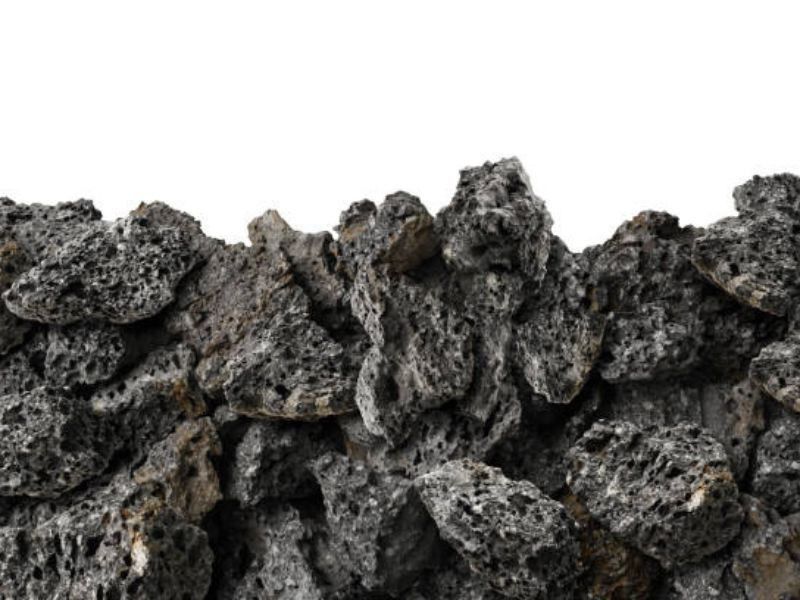
One might think any garden soil would be suitable, but this is a prevalent misconception. Garden soil, while suitable for larger plants, might not cater to the unique needs of bonsai trees. Such soils can retain too much water, potentially leading to root rot. Contrastingly, a carefully crafted bonsai soil mix ensures the right balance of good water retention and drainage.
The bonsai soil mix is a specialized concoction, uniquely designed to cater to the specific needs of bonsai trees. Elements often found in high-quality bonsai soil mixes, such as:
- lava rock,
- peat moss, and
- pine bark,
guarantee optimal water retention while simultaneously ensuring efficient drainage. This delicate balance ensures that the root system receives the exact amount of water it requires, eliminating the risk of becoming waterlogged.
Basics Of Soil Composition
Soil composition, especially in bonsai cultivation, is more than just dirt; it’s an intricate blend that determines the health and vitality of the bonsai tree. Essentially, we can classify soils into two main categories: organic and inorganic.
Organic soils
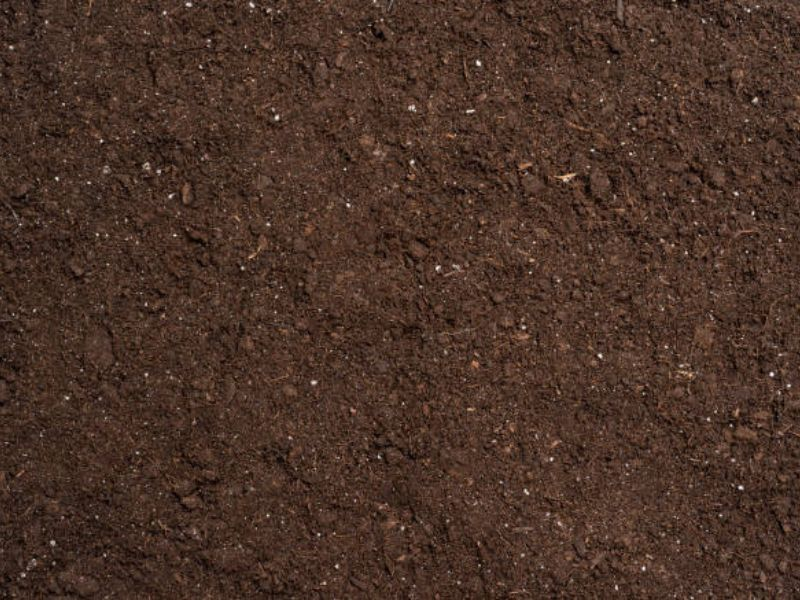
Crafted from once-living materials like decomposed plants or animals. Like peat moss, pine bark, and other organic soil components stand out because they offer beneficial water retention. However, there’s a challenge: over time, organic components can break down, leading to compacted organic soil. This compacted nature can impede root growth and minimize the amount of fresh air reaching the roots.
Inorganic soils
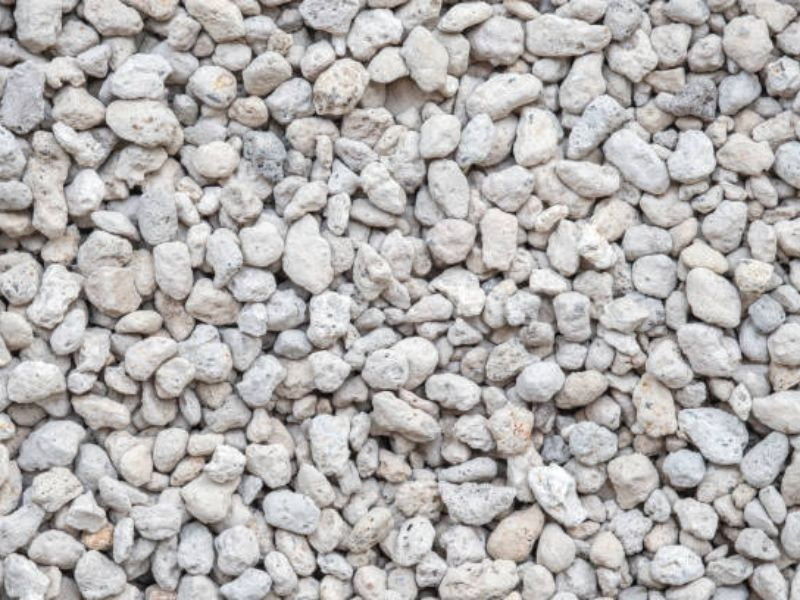
Soil mixes, often denoted by elements like lava rock, pumice, and akadama, are mineral-driven. These inorganic compositions ensure the bonsai soil mix drains well, making them invaluable for preventing root rot and establishing a healthy tree root system.
The art of bonsai demands a balance between these organic and inorganic soil mixes, illustrating the critical role of soil types in bonsai. A well-calibrated bonsai soil mix not only retains sufficient quantities of water but also guarantees proper drainage, which is essential for root growth and general tree health.
Deep Dive Into Soil Components
The foundation of a flourishing bonsai tree lies in the intricate blend of soil components it rests upon. These components, both organic and inorganic, are carefully chosen to tailor the soil’s properties, ensuring optimal water retention and drainage.
Let’s delve deeper into understanding these vital elements.
Inorganic Components
- Lava Rock: An integral part of many inorganic soil mixes, lava rock is a porous, airy material that enhances drainage while retaining enough moisture for the tree’s needs. Its coarse structure ensures the soil doesn’t become compacted, allowing roots to breathe and expand.
- Inorganic Soil Mixes: Apart from lava rock, there are other inorganic components like pumice and akadama. These materials offer excellent drainage properties, ensuring the bonsai soil mix drains well and preventing potential root rot scenarios. Their stable nature also means they won’t break down easily, preserving the soil structure over longer periods.
Organic Components
- Peat Moss: A staple in many organic soil mixes, peat moss is valued for its excellent water retention properties. It absorbs moisture and releases it slowly to the plant’s roots, ensuring a steady supply of water.
- Pine Bark: Another common ingredient in organic bonsai soil, pine bark improves the soil’s texture, aids in moisture retention, and slowly breaks down, releasing vital nutrients to the bonsai tree.
- Other Organic Soil Components: Beyond the aforementioned, there are various other organic components like compost, leaf mold, and coconut coir. Each contributes to the soil’s texture, water retention, and nutrient content in its unique way.
Impact On Water Retention And Drainage
The balance between these organic and inorganic components determines the soil’s water retention and drainage properties.
While organic materials like peat moss and pine bark retain moisture, inorganic elements like lava rock ensure excess water drains away. This equilibrium prevents the root system from becoming waterlogged while ensuring it remains sufficiently moist.
Adapting Techniques For Different Soil Types
Just as every bonsai tree is a unique work of art, so too are the soil needs for each species. To truly master bonsai cultivation, understanding and adapting to different soil types is paramount, particularly the specific soil types in bonsai. This knowledge is key to nurturing each tree according to its individual requirements.
Tailoring Bonsai Mix Based On Tree Species
It’s crucial to remember that not all trees need the same kind of nourishment. For instance, the soil mix perfect for a juniper might not be the best choice for a maple. Different tree species have evolved in various terrains and have unique soil preferences.
Deciduous Trees And Organic Bonsai Soil
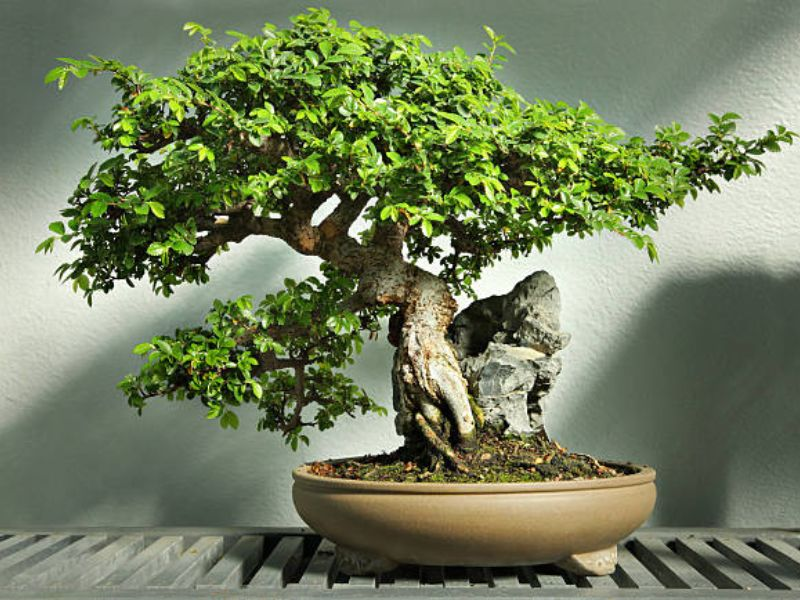
Deciduous trees, which shed their leaves annually, have a natural inclination towards organic bonsai soil. The science behind this lies in their native habitats, where they flourish in soil rich in decomposed organic matter.
Organic soil components, like peat moss and pine bark, mimic this environment, offering a rich mix of nutrients and optimal water retention. Such bonsai soils support the robust root growth and nutrient absorption these trees need.
Preventing Overwatering And Root Rot
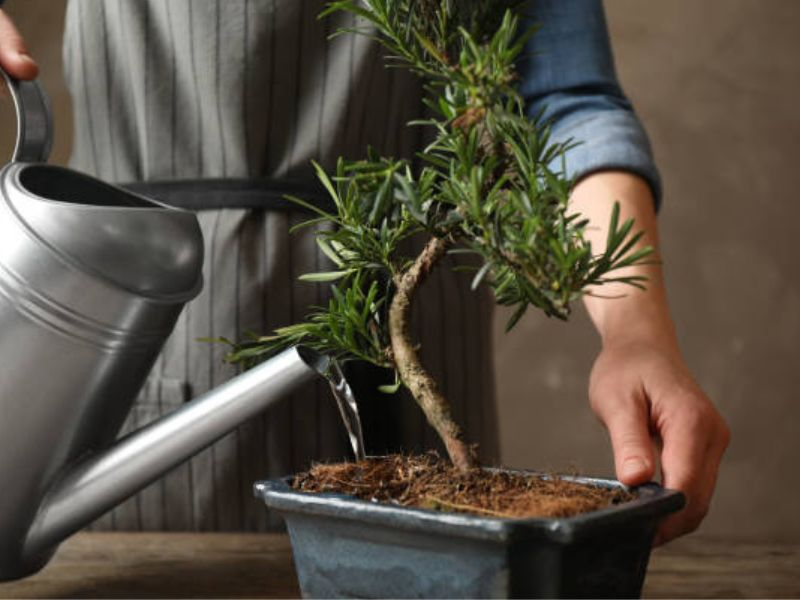
Overwatering is a common pitfall in bonsai cultivation, leading to the dreaded root rot. To mitigate this risk, it’s essential to understand the drainage properties of your chosen soil.
Inorganic soil mixes, for instance, offer excellent drainage, reducing the chance of water stagnation. On the other hand, compacted organic soil might retain too much water. Regularly checking the bottom of the pot and ensuring that it drains well can provide insights into when to water next.
Adjusting Water Amounts Based On Soil Composition
Different soil compositions have varied water requirements. A bonsai planted in a predominantly inorganic mix might require more frequent watering than one in an organic-rich mix, which retains water longer. Observing the soil surface can give clues: if it appears dry or if the pot feels significantly lighter, it’s probably time to water.
The Role Of The Bonsai Pot
Historically, bonsai pots have evolved in design, material, and purpose. The ancient pots were simple containers, with aesthetics often taking a backseat. However, as bonsai cultivation developed into an art form, the pots transformed too. Modern-day bonsai enthusiasts can choose from a wide range of pots, each uniquely crafted to complement the tree’s aesthetics while ensuring its health.
Connection Between The Bonsai Pot’s Design And Drainage
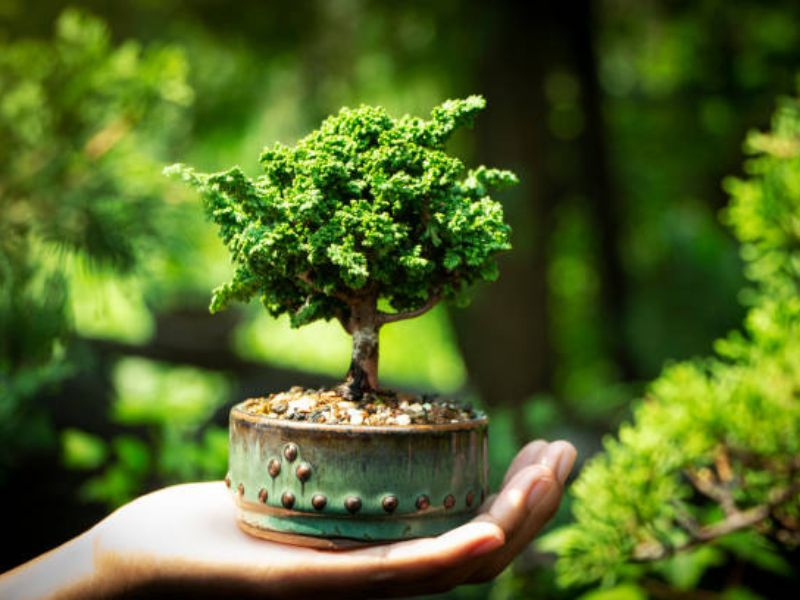
The design of the bonsai pot, particularly the bottom of the pot, is crucial for effective drainage. A well-designed pot should facilitate quick water exit, preventing waterlogging and potential root rot. The number and size of drainage holes, the pot’s depth, and its shape all influence how effectively water drains.
For instance, a shallow, wide pot may facilitate faster evaporation than a deeper one. This design intricacy ensures that the bonsai soil mix remains aerated, providing the roots with much-needed fresh air.
Signs Your Bonsai Planted Pot Requires A Change In Soil Mix
Regular maintenance is key to bonsai health, and changing the soil mix is part of this regimen. Generally, every 2 years, it’s advisable to assess the soil condition and consider repotting.
Signs to look for include:
- The soil appears compacted, making it hard for water to penetrate.
- Water retention at the soil surface, indicating poor drainage.
- Noticeable reduction in the tree’s growth or vitality.
- The bonsai tree’s root system outgrows the pot, circling or matting at the bottom.
Taking note of these signs and remembering the 2-year guideline can ensure that your bonsai tree continues to thrive in optimal conditions.
Perfecting The Bonsai Soil Mix
A good quality bonsai soil is not about just any soil; it’s about understanding and choosing the right soil types in bonsai, creating the perfect environment for the tree to thrive.
Key factors to consider are:
- Drainage Capacity: The bonsai soil mix must allow excess water to drain quickly, preventing root rot and fungal infections. Inorganic components often play a pivotal role in ensuring good drainage.
- Water Retention: While drainage is crucial, the soil should also retain sufficient quantities of water. Organic soil components like peat moss and pine bark can help in maintaining the right moisture levels.
- Aeration: The root system needs access to fresh air for optimal growth. Soil that’s too compacted can suffocate roots, while a well-aerated mix promotes healthy root expansion.
- Nutrient Supply: Supplying essential nutrients to the bonsai tree is paramount. A mix of organic and inorganic components can ensure a steady supply of vital nutrients.
Balance For Optimal Root Growth And Water Retention

Striking the right balance in the soil mix is about understanding the symbiotic relationship between water retention and root growth. For instance, while organic bonsai soils offer excellent water retention, they need to be complemented with inorganic materials to prevent waterlogging and promote aeration.
Regularly testing the water retention of the soil and adjusting its composition can ensure the tree gets its requisite moisture without the risks of stagnation.
Testing And Adjusting Soil Mixes For Specific Bonsai Tree Needs
No two bonsai trees are alike, and neither should their soil be. A juniper might prefer a grittier mix, while a ficus may flourish in a more organic-rich environment.
- Start Small: Before repotting your entire bonsai, test new soil mixes in smaller containers or with cuttings.
- Observe and Adapt: Monitor how the tree responds to the new soil mix – from its growth rate to leaf color and overall vitality.
- Feedback Loop: Based on observations, make iterative changes to the soil composition. This continuous feedback loop ensures that you tailor the mix to the specific needs of your bonsai tree over time.
In the journey of bonsai cultivation, perfecting the soil mix is an ongoing process, demanding attention, patience, and a willingness to adapt and learn.
Key Considerations For Bonsai Soil Maintenance
Bonsai soil maintenance goes beyond periodic watering and fertilizing. It’s about understanding the subtle cues the soil provides, and in response, nurturing an environment where the bonsai can flourish.
The Art Of Monitoring And Interpreting The Soil Surface’s Appearance
One can infer much about the bonsai’s health and the soil’s condition just by observing its surface.
Here are some cues:
- Dry and Crusty: Indicates too much water evaporation and might suggest the need for a soil mix that retains more moisture.
- Moss or Algae Growth: While they might add an aesthetic appeal, their presence could indicate overly damp conditions which might not be ideal for certain bonsai trees.
- Discoloration: A pale or white-ish soil surface might hint at mineral deposits, signifying hard water usage or over-fertilization.
Ensuring Fresh Air Reaches The Root System
For a bonsai to thrive, its root system must consistently receive fresh air. This requirement underscores the importance of a well-draining soil, a key characteristic of the right soil types in bonsai. Soil that supplies moisture but doesn’t become waterlogged ensures roots remain oxygenated.
This balance prevents root rot and supports healthy root growth. Regularly aerating the soil, using tools or gentle finger prodding, can prevent compaction and ensure airflow.
Compacted Organic Soil And Balance Between Soil Components
- Compacted Organic Soil: Over time, organic components like peat moss or pine bark can decompose and compact. Such soil restricts root growth and reduces water penetration. Addressing this involves either adding grittier components or repotting with a fresh bonsai soil mix.
- Balance Between Soil Components: The dance between organic and inorganic soil components is a delicate one. Too much organic matter might retain excess water, while a highly inorganic mix might not supply moisture adequately. Regularly assessing the soil’s texture, its water retention capability, and the bonsai’s response can guide adjustments to achieve the desired balance.
Bonsai soil maintenance is a hands-on, observational art. It requires a bonsai enthusiast to be attuned to the tree’s needs, ready to intervene when the soil signals distress or imbalance.
Embarking On A Continuous Journey Of Soil Experimentation
In the realm of bonsai cultivation, there’s an adage that resonates deeply: Learning never ceases. Every bonsai tree, with its unique personality and requirements, beckons enthusiasts to delve deeper, explore more, and continually refine their understanding. And at the heart of this exploration lies the dynamic world of bonsai soil.
Like a symphony orchestra where every instrument contributes to the harmony, each soil component in a bonsai mix plays a crucial role. Yet, there’s no one-size-fits-all solution. What works for a juniper might not be ideal for a maple. What thrives in one climate might falter in another. It’s this intrinsic variability that makes bonsai soil experimentation not just important, but vital.
Why Experiment?
- Discover New Mixes: By playing around with different soil components, from lava rock and pine bark to inorganic soil mixes, one can stumble upon a combination that might just be the magic mix your bonsai craves.
- Adapt to Changing Needs: As bonsai trees mature and grow, their soil needs can evolve. Regular experimentation ensures the soil keeps pace with the tree’s changing requirements.
- Overcome Challenges: Facing issues like poor water retention or root rot? Experimenting with the soil mix can often be the remedy. It’s about diagnosing the problem and tweaking the soil composition accordingly.
Plant Selection For Bonsai: Matching Bonsai Trees To Soil Types
Matching bonsai to soil is an essential cornerstone in the intricate art of bonsai cultivation. This practice ensures the health, vitality, and aesthetic appeal of these miniature masterpieces. While many admire bonsai for their beauty, fewer recognize the meticulous care and deep knowledge required behind the scenes, especially when it comes to the symbiotic relationship between the tree species and their respective soils.
The Diversity of Bonsai Trees
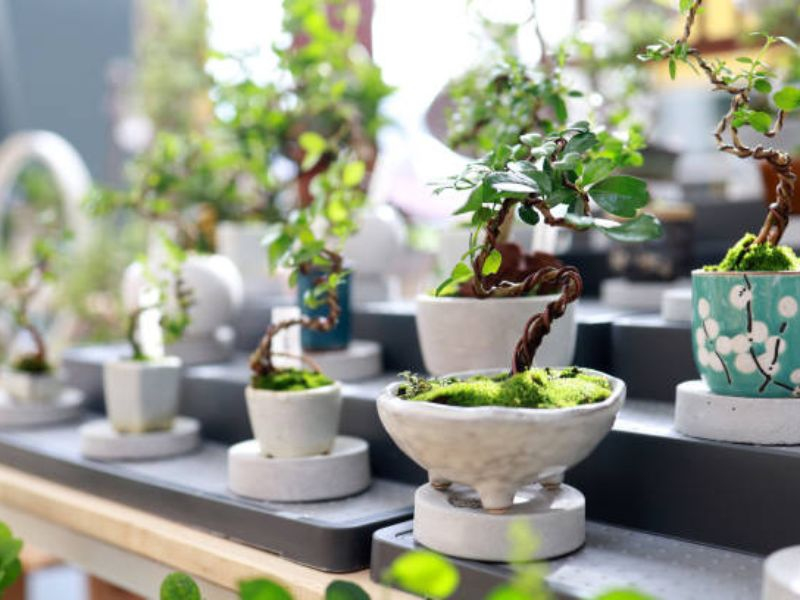
While almost any tree can be cultivated as a bonsai, certain characteristics make some species more suitable. The adaptability of the tree to thrive in a confined space, its resilience to frequent pruning, and the aesthetics of its foliage, bark, and roots play a crucial role.
Additionally, the tree’s response to bonsai cultivation techniques and its ability to exhibit the desired “mature looking plant” appearance in miniature form are vital factors.
Characteristics Of Deciduous Trees And Their Popularity
Deciduous trees, recognized by their seasonally shedding leaves, are among the most popular choices for bonsai enthusiasts. Their cyclic transformation — budding in spring, flourishing in summer, changing colors in autumn, and shedding in winter — offers a dynamic visual experience.
Matching bonsai to soil is crucial, especially for species like maple, oak, and elm, which are beloved for their vibrant autumnal displays. Deciduous tree species also often have smooth bark, adding a textured elegance to the overall presentation. Their predictable growth patterns and responsiveness to pruning make them favorites in the bonsai garden.
Special Species Highlight: Maple Bonsai
Renowned for their fiery autumn hues, intricate vein patterns on leaves, and smooth bark, they encapsulate the essence of a deciduous bonsai. The maple bonsai is a testament to how a specific tree species can perfectly match with the right soil mix, ensuring vibrant colors and healthy growth.
Its widespread popularity has made it a subject of extensive study and experimentation, leading to advanced bonsai cultivation techniques tailored just for maples.
Indoor Vs. Outdoor Bonsai: Differences In Care And Presentation
While many bonsai trees thrive outdoors, some species are better suited for indoor cultivation. Indoor bonsai trees, such as certain tropical species, require consistent temperatures and humidity levels. They benefit from indirect sunlight and may need supplemental lighting.
On the other hand, outdoor bonsai trees, like many deciduous trees and pines, require exposure to natural seasonal changes. The presentation also varies; indoor bonsais might be paired with accent plants that can thrive in similar conditions, while outdoor bonsais can be showcased in arrangements that mimic natural landscapes.
The Science of Bonsai Soils
Bonsai soil differs significantly from regular garden soil. Designed to provide optimal drainage, aeration, and nutrient retention, bonsai-specific soils are the lifeline of these miniature trees.
While the exact mixture can vary based on the tree species and climatic conditions, bonsai soils usually contain a mix of granular inorganic materials, combined with some organic materials, ensuring the root systems receive the necessary oxygen and nutrients.
A Deeper Look At Soil Particles And Their Significance
Soil particles play a pivotal role in determining the health of a bonsai tree. The size and consistency of these particles impact water retention, aeration, and root growth. Coarse particles ensure good drainage, preventing root rot, while finer particles help retain essential nutrients.
A balanced mix, considering the specific needs of the bonsai tree species, can promote healthy root growth and prevent soil compaction. For instance, certain tree species might require a soil mixture with larger particles for better aeration, while others may thrive in a finer blend.
Organic Vs. Inorganic Components
Bonsai soils typically contain a mix of both organic and inorganic components. Organic materials, such as pine bark or compost, offer essential nutrients and assist in moisture retention.
In contrast, inorganic materials, like akadama, pumice, or lava rock, provide structure and promote drainage. The balance between these components is crucial. For instance, deciduous trees might benefit from a slightly richer organic content, while pine trees might prefer a soil with higher inorganic content.
Ensuring the right pH level for different tree species
Different tree species have specific pH preferences. While some bonsai trees prefer slightly acidic conditions, others thrive in neutral or slightly alkaline soils. Regularly testing the soil pH and making necessary adjustments ensures that the tree can absorb essential nutrients effectively.
If the pH is too high or too low, it can lock out certain nutrients, causing deficiency symptoms. Using pH modifiers or selecting the right soil mix can help maintain optimal pH levels tailored to the specific bonsai species.
Matching Bonsai Tree Species to Soil
Deciduous trees, with their seasonal transformations, have specific soil preferences. They often benefit from a soil mix that has a balanced blend of organic and inorganic materials. Organic materials provide the necessary nutrients during the growing season, while the inorganic components ensure adequate drainage, essential for the tree’s dormant winter phase.
A popular example is the maple bonsai, which thrives in a well-draining soil mix enriched with organic material, supporting its vibrant autumnal display.
Trees With Unique Requirements
Every tree species brings its set of requirements to the bonsai table, making matching bonsai to soil a critical aspect of care. Trees with smooth bark, like beeches, might prioritize good aeration to prevent bark diseases, necessitating a soil mix with larger inorganic particles. On the other hand, trees producing ornamental features, like orange fruits, might require richer soil.
This ensures they receive the necessary nutrients for fruit production without compromising the health of the tree. For such trees, a soil mix with a higher proportion of organic materials, ensuring sustained nutrient release, might be optimal.
Let’s delve deeper into some particular tree species and the soil compositions they prefer:
Ficus (Fig) Bonsai

- Soil Preference: Ficus trees prefer well-draining soils with moderate water retention properties. A mix of akadama, lava rock, and a bit of pine bark can work wonders.
- Reason: Ficus trees are drought-tolerant and dislike being waterlogged. The blend ensures the right moisture levels while preventing root rot.
Azalea Bonsai
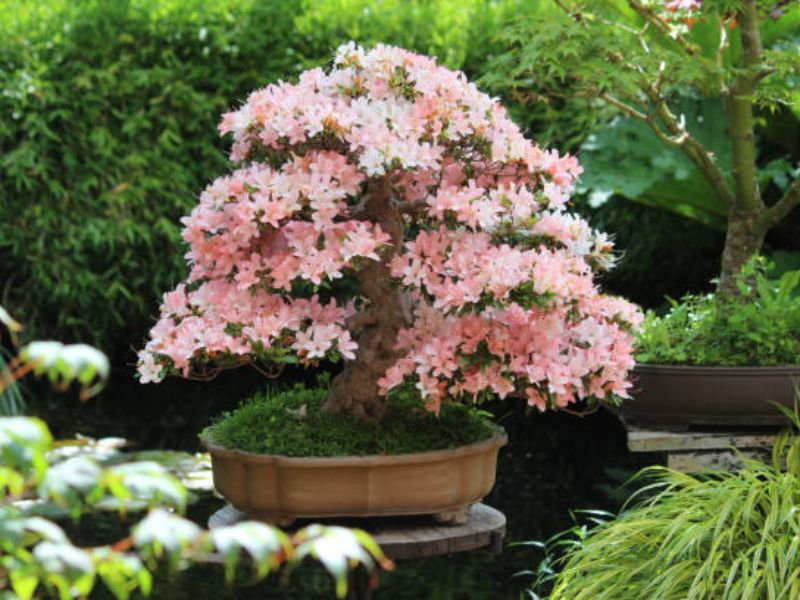
- Soil Preference: Azaleas thrive in acidic soils. A combination of kanuma (an acidic substrate), pine bark, and sphagnum moss can be ideal.
- Reason: Azaleas need an acidic environment for optimal nutrient uptake. Kanuma naturally lowers soil pH, promoting healthy growth.
Juniper Bonsai
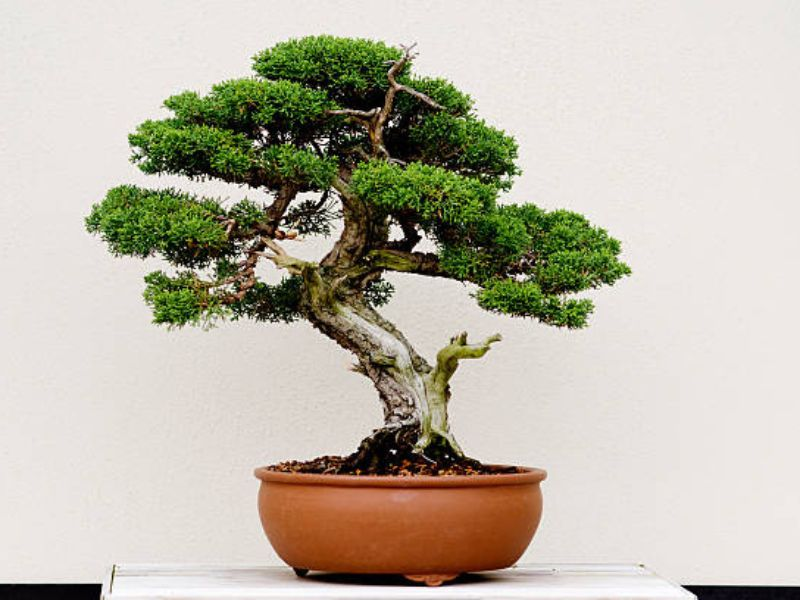
- Soil Preference: Junipers benefit from a well-draining, gritty soil. A mix of pumice, akadama, and a small amount of organic material like pine bark can be perfect.
- Reason: Junipers are susceptible to root rot. The gritty composition ensures quick drainage, keeping the roots healthy.
Pomegranate Bonsai (With Orange Fruits)
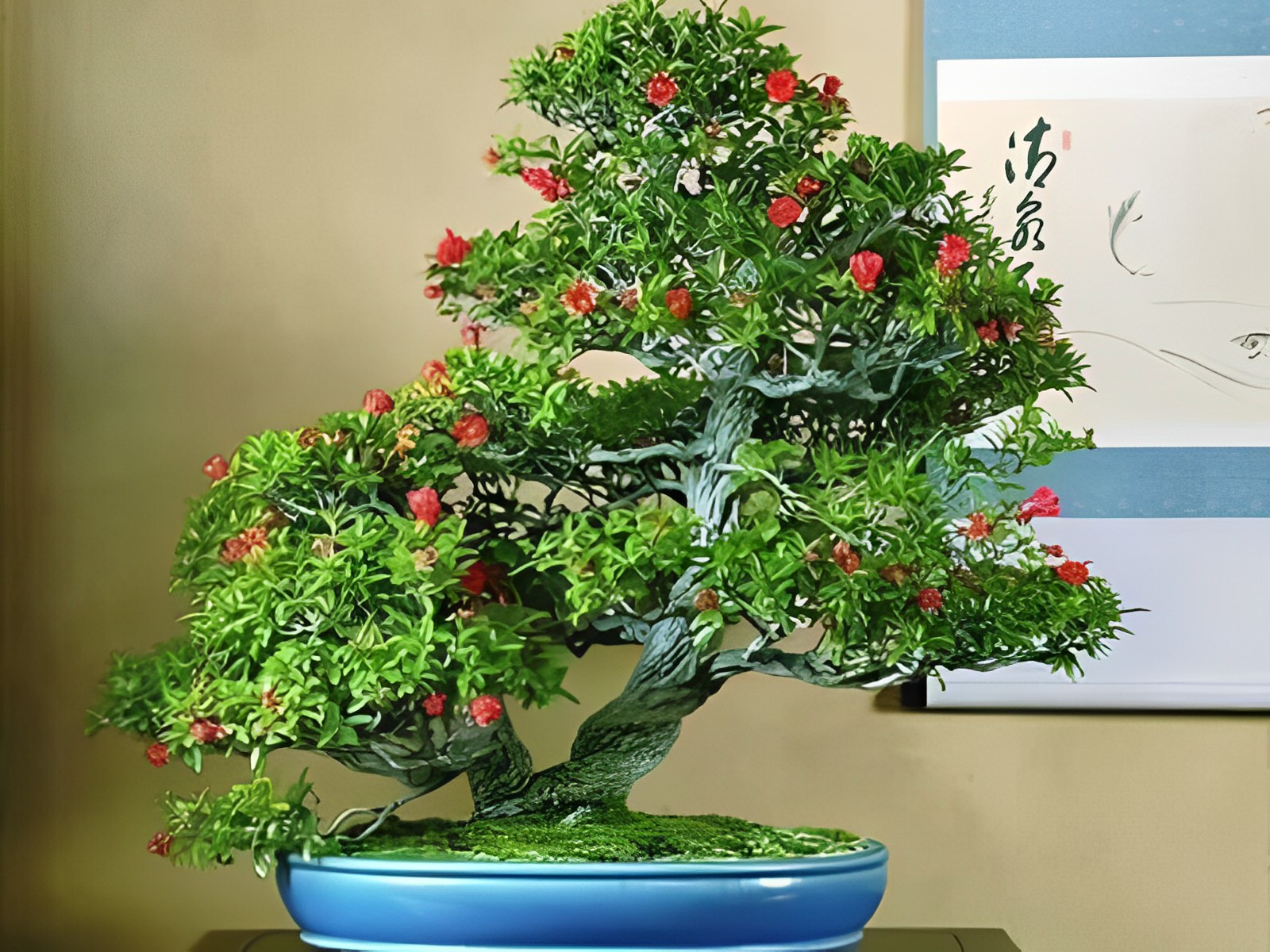
- Soil Preference: This fruit-producing bonsai tree requires a nutritious and slightly acidic soil mix. Combining akadama, lava rock, pine bark, and some peat moss can create an ideal blend.
- Reason: The soil supports the tree’s energy-intensive fruiting process and ensures the vibrant color of the fruits.
Beech Bonsai (Smooth Bark)
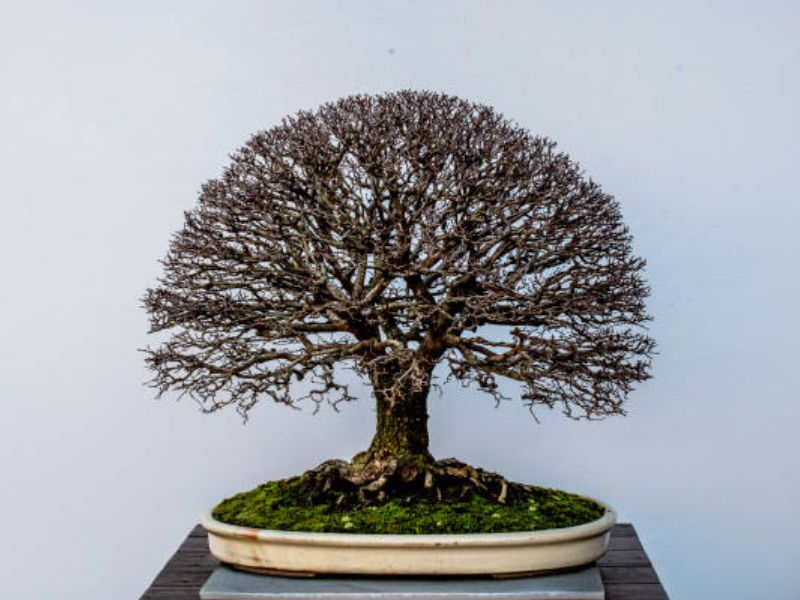
- Soil Preference: Beeches appreciate a well-aerated soil that retains moisture without waterlogging. A mix of akadama, pumice, and a bit of composted bark suits them.
- Reason: Good aeration prevents diseases on their smooth bark, and the mix maintains a balanced moisture level for their roots.
Pine Bonsai
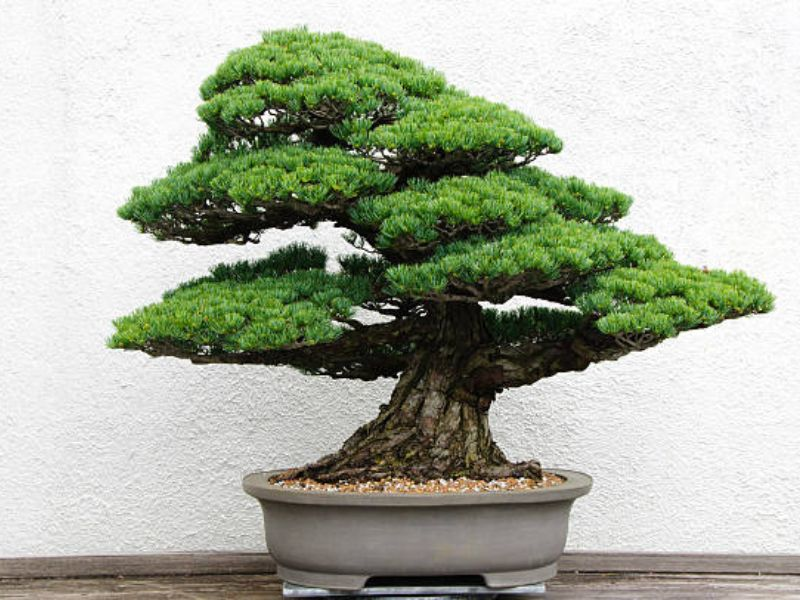
- Soil Preference: Pines are unique and need sharply draining soil. A blend of akadama, lava rock, and a minimal amount of organic material can be optimal.
- Reason: Pines don’t favor waterlogged conditions, and the blend ensures quick drainage while providing essential nutrients.
Elm Bonsai
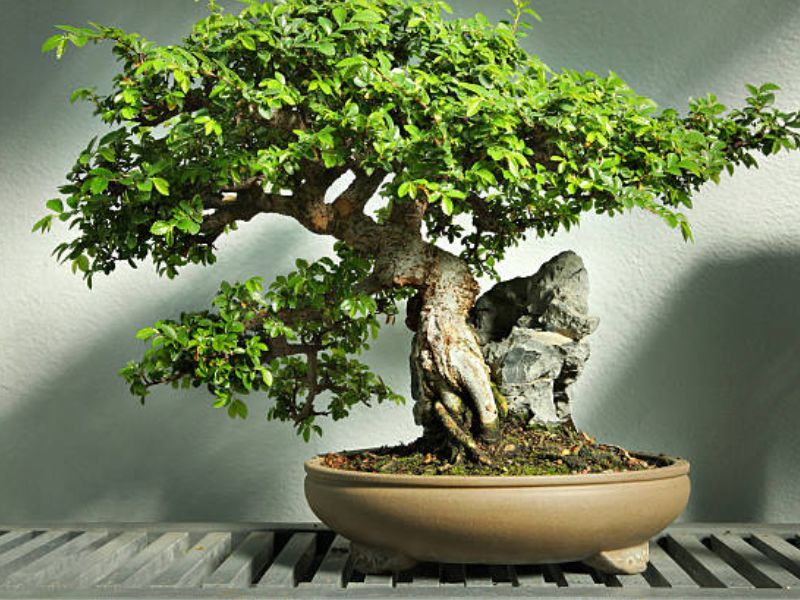
- Soil Preference: Elms are versatile and can tolerate a variety of soils. However, a mix of akadama, lava rock, and a bit of compost works best for them.
- Reason: They require good drainage but also need consistent moisture. This blend provides both, ensuring the elm thrives in its miniature form.
Bougainvillea Bonsai
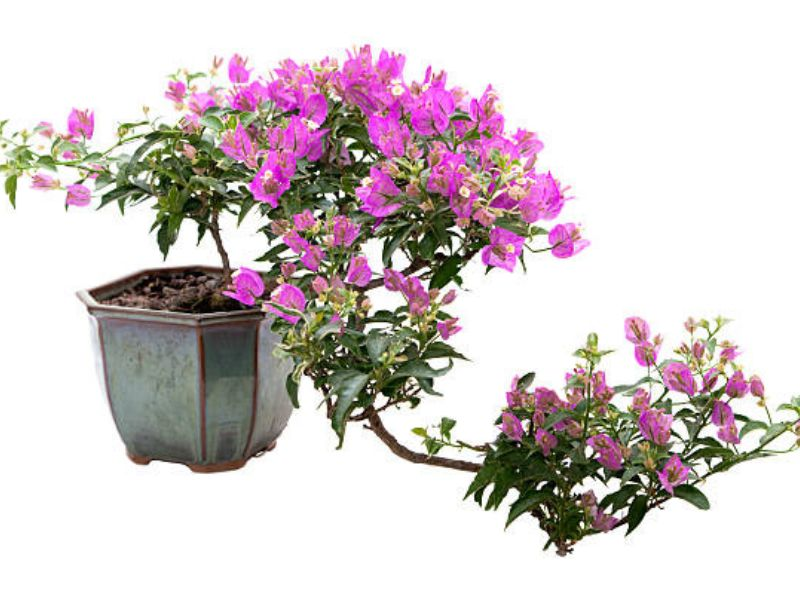
- Soil Preference: These vibrant flowering trees prefer a well-draining soil with good aeration. A combination of pumice, akadama, and some coconut coir can be ideal.
- Reason: Bougainvilleas are accustomed to drier conditions, and this mix prevents over-watering while supporting their brilliant bloom cycle.
Cypress Bonsai
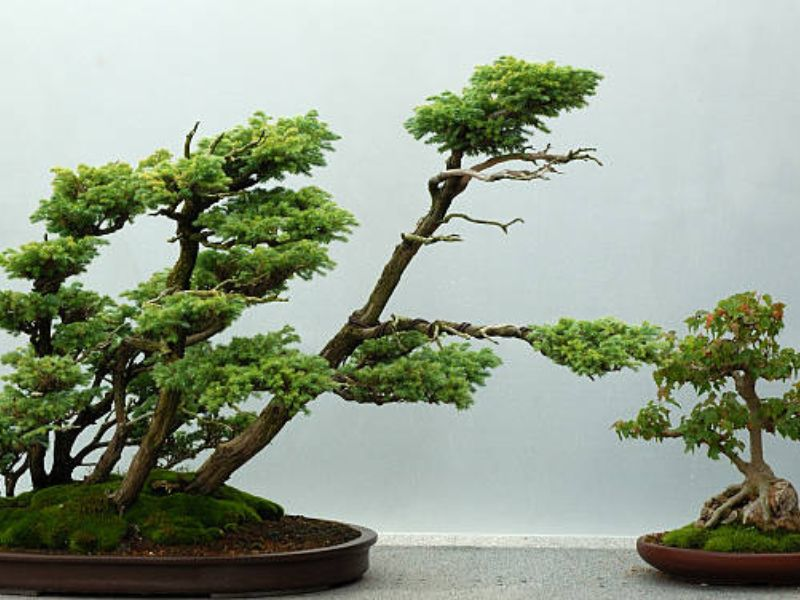
- Soil Preference: Cypresses love moisture-retentive yet well-draining soils. A blend of akadama, sand, and peat moss creates the right environment.
- Reason: These trees naturally grow in swampy areas. While they love moisture, in the confined space of a bonsai pot, good drainage is essential to prevent root rot.
Cherry Blossom Bonsai
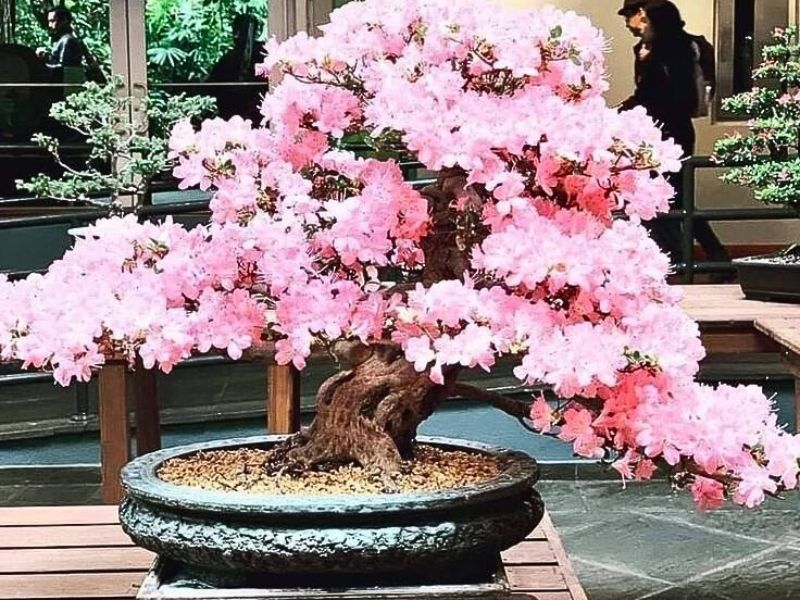
- Soil Preference: These iconic trees, known for their stunning blooms, thrive in a mix of akadama, volcanic grit, and a bit of compost.
- Reason: Cherry blossoms need a soil that supports their flowering phase while ensuring adequate drainage. This mix ensures they bloom profusely and maintain good health.
The Challenge of Indoor Bonsai
Cultivating bonsai trees indoors presents a unique set of challenges, especially when it comes to soil composition. Indoor environments typically lack the natural fluctuations of outdoor settings, leading to specific soil needs.
The absence of natural elements like rain means that the soil must provide excellent drainage to prevent overwatering.
Matching bonsai to soil is particularly important for indoor bonsai trees, which might require more frequent watering. Therefore, a soil mix that retains moisture without becoming soggy is crucial. Incorporating materials like perlite or sand can aid in drainage, while organic materials can ensure the soil remains moist enough between waterings.
The Role of Bonsai Pots

How Bonsai Pots Have Evolved Over Time
Traditionally, pots were handcrafted, with artisans giving meticulous attention to detail, ensuring that each pot not only served its functional purpose but also complemented the aesthetic of the bonsai tree. They were typically made of clay, with earthy, muted tones and were often unglazed.
In contrast, modern pots, while retaining some traditional elements, embrace contemporary design influences and materials. Today, you’ll find pots made of various materials, ranging from ceramics to plastics, each catering to a different aesthetic and functional need.
Additionally, modern advancements have enabled the creation of pots with better drainage systems, catering to the nuanced requirements of specific bonsai tree species.
Unglazed Vs. Glazed Pots, And Their Effects On Soil Moisture
The unglazed bonsai pot, much like traditional clay ones, is porous. This quality allows it to absorb excess moisture, preventing waterlogged conditions, a boon for trees like pines that dislike overly wet roots.
Glazed pots, with their shiny finish, are less permeable. They retain moisture more efficiently, making them suitable for tree species that require consistent soil moisture, like certain tropical bonsai plants.
How Pot Dimensions Influence Root Growth
Small pots naturally restrict root growth, leading to a slower-growing and often more miniature tree. This confinement can be used strategically to stunt growth or create a desired shape.
Rectangular pots, with their broader base, allow for expansive root growth. They are often chosen for larger bonsai trees or those species that benefit from a wider rooting area. Conversely, tall pots might be selected for trees with deep root systems.
Root Health: Techniques Like Root Pruning For Optimizing Health

Given the confined space of bonsai pots, roots can easily become overcrowded, leading to reduced nutrient uptake and potential root rot. Root pruning becomes a vital technique in this art, ensuring the tree remains healthy. By regularly pruning and thinning out the root ball, bonsai enthusiasts can ensure that the tree receives adequate nutrients and water.
Moreover, this practice also stimulates newer, healthier root growth, reinforcing the tree’s health and vigor.
Other Techniques For Optimizing Root Health
- Root pruning is crucial for bonsai trees because their roots can get overcrowded in small pots. This can lead to poor growth and nutrient absorption. By trimming the roots regularly, you can keep them healthy and the tree thriving.
- To keep the soil from getting too compacted, poke some holes in it now and then. This lets air reach the roots, helping them breathe and absorb nutrients better.
- Choose the right soil for your bonsai to avoid over or under-watering. Good drainage prevents water from pooling around the roots, which can cause rot. If your tree needs lots of water, pick soil that holds onto moisture well.
- Repot your bonsai every few years to refresh the soil and check the roots for any issues. Washing the roots during repotting helps get rid of old soil and lets you see if there are any rotten or dead roots to remove.
- Some bonsai enthusiasts add mycorrhizal fungi to their trees to help the roots absorb more nutrients and stay healthy.
- Keep an eye on the temperature, especially in extreme weather. Cold temperatures can harm roots, so protect your bonsai during chilly months. In hot weather, move it to a cooler spot to prevent the roots from burning.
- Give your bonsai the right fertilizer, but be careful not to overdo it. Too much fertilizer can hurt the roots, so stick to the recommended amounts for your tree.
Enhancing Bonsai Presentation
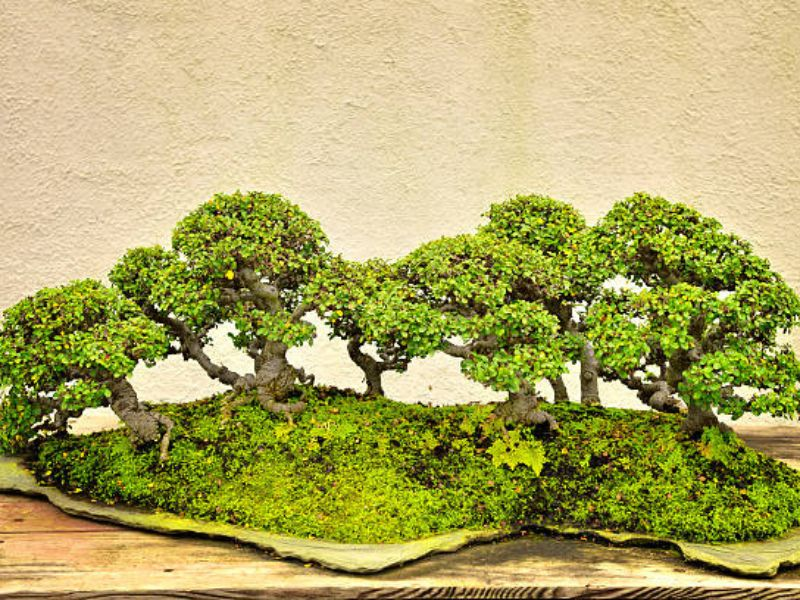
The right presentation amplifies the beauty of the bonsai and provides context, making it a living piece of art.
Here’s how enthusiasts elevate their bonsai displays:
Accent Plants In Bonsai Art
Accent plants, known as kusamono or shitakusa in Japanese, serve as complementary elements in bonsai displays. Their role is multifaceted. They not only highlight the main tree’s features but also signify the season or natural environment in which the bonsai exists.
For example, a flowering accent plant might indicate spring, while a grassy one might evoke a meadow setting.
Matching bonsai to soil is a practice deeply rooted in Japanese aesthetics, mirroring the philosophy behind these meticulous additions. It’s about capturing the essence of nature and representing a harmonious natural world in miniature form.
Using Grasses And Fruits
Tall grass varieties, with their slender and waving forms, add dynamism to a bonsai display. They provide contrast, especially against the structured and often rigid forms of bonsai trees. Grasses can also represent the wilderness, adding a sense of naturalism to the scene.
Fruits, like orange fruits, serve a dual purpose. Firstly, they add a burst of color, drawing the eye and creating visual interest. Secondly, they symbolize fertility, abundance, and the cyclical nature of life.
A fruit-bearing tree in a bonsai display, especially when paired with a complementary accent plant, can depict a fruitful season, evoking feelings of prosperity and bounty.
How To Arrange Multiple Bonsai Trees And Accent Plants
A bonsai garden display is like an orchestration where each element, from trees to accent plants, plays a specific role. The arrangement is vital.
- Height and Scale: Start with your most prominent tree and use it as an anchor. Other trees and plants should be positioned in a way that they lead the viewer’s eye towards this centerpiece.
- Contrast and Harmony: Vary the types of trees and plants for contrast, but ensure there’s a harmonious flow. For instance, a maple bonsai with its vibrant red leaves can be juxtaposed against a pine with its evergreen needles.
- Spacing: Avoid clutter. Give each tree and plant enough space so they can be appreciated individually, yet ensure they come together as a cohesive unit.
- Storytelling: Think of your display as a narrative. Maybe it’s a mountain landscape, with tall trees, followed by shorter ones, and then grasses representing the plains below.
- Seasonal Considerations: Change accent plants according to the season. This not only keeps the display fresh but also aligns with the natural world’s rhythms.
Enhancing bonsai presentation is about understanding the principles of design and storytelling. With careful thought, a bonsai display can be transformed into a captivating tableau, providing viewers with a profound connection to nature and its intricate beauty.
Advanced Care Tips
Advanced care techniques ensure that the bonsai remains healthy, vibrant, and true to its natural form.
Here’s a deep dive into some of these care methodologies:
Ensuring Optimal Moisture For Various Bonsai Soils
- Understand the Soil: Different bonsai soils retain water differently. While some may require daily watering, others might benefit from alternate day hydration. Before developing a watering routine, understanding your bonsai soil’s water retention properties is crucial.
- Use the Finger Test: Insert a finger up to an inch into the soil. If it feels dry, it’s time to water. If it feels moist, wait a day or two.
- Watering Depth: When watering, ensure that water seeps through and drips from the drainage holes. This ensures that the entire root ball is moistened.
- Misting: Especially for indoor bonsai or during dry seasons, misting the leaves can provide humidity and prevent the leaves from drying out.
- Avoid Water Logging: Ensure the pot has adequate drainage. Sitting in water can cause root rot, detrimental to the tree’s health.
Meeting The Nutritional Needs Of Bonsai Trees
- Know Your Tree: Different tree species have unique nutritional requirements. While a maple might need a balanced fertilizer, a flowering species might benefit from one rich in phosphorus.
- Frequency: Over-fertilizing can harm the bonsai. Typically, during the growth season (spring and early summer), fertilizing can be done bi-weekly. In the dormant season (winter), reduce it to once a month or skip it altogether.
- Types of Fertilizers: In the process of matching bonsai to soil, gardeners must consider the use of organic and inorganic options. Organic fertilizers release nutrients slowly and are generally gentler, while inorganic ones provide immediate nutrient boosts.
- Application: Use a fertilizer with small particle size, ensuring it gets to the roots. If you’re using liquid fertilizers, dilute as per instructions and water the bonsai afterward to prevent root burn.
Modifying Care Routines Based On Seasons
- Winter Care: Protect the bonsai from frost. While some species can handle cold, extreme temperatures can damage or kill others. Also, reduce watering since the tree’s metabolic rate drops.
- Spring: As the growth season begins, increase watering and start your fertilizing routine. Look out for pests and diseases, as this is when they are most active.
- Summer: Protect the bonsai from extreme heat and direct sunlight. Water more frequently but in smaller amounts. This is also a good time for some light pruning to shape the tree.
- Autumn: Reduce fertilizing as the tree prepares to go dormant. This is an excellent time for major pruning and wiring, as the tree is robust and can handle the stress.
Advanced care techniques revolve around being attuned to the tree’s needs and responding accordingly. A well-tended bonsai can live for generations, serving as a testament to the caretaker’s dedication and understanding of this intricate art form.
The Path Forward
Embrace the journey of soil experimentation wholeheartedly. Dive deep into the world of organic and inorganic components. Understanding the soil types in bonsai is essential in this journey. Challenge the status quo, question established norms, and always, always keep learning.
The path to bonsai mastery is paved with trials, errors, and triumphant discoveries. It demands patience, passion, and persistence. But the reward? A thriving, flourishing bonsai tree that stands as a testament to your dedication and love.
So, with your bonsai by your side and soil beneath your fingers, embark on this beautiful journey. Because in the world of bonsai, every grain of soil holds a lesson, and every tree tells a story.


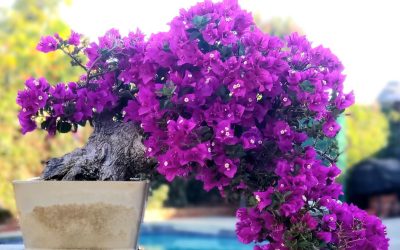
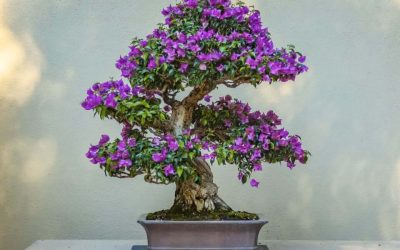
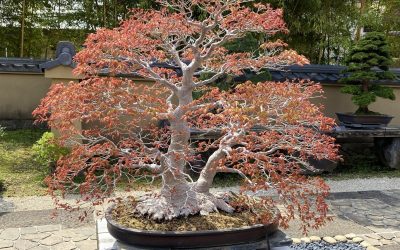
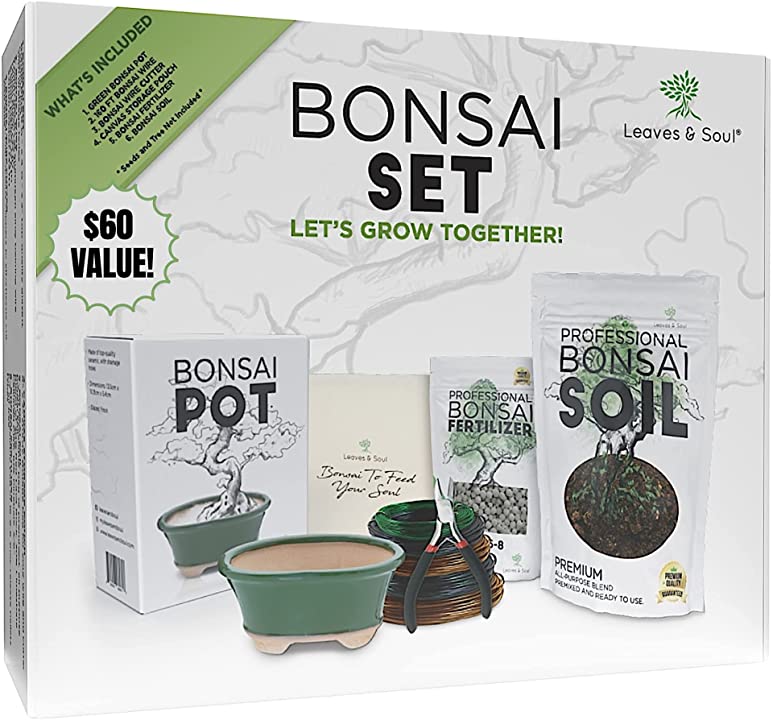
0 Comments